Crate training a puppy requires a great deal of patience, persistence, and consistency, but the time and effort put in during those first few months will be well worth it for the dog’s safety and for your peace of mind. (not to mention your sanity…?)
Many people choose not to crate train their puppy because they feel bad for the dog, and think that this method of training is cruel. Some people don’t crate train because they simply have no idea where to start.
In this article we are going to chat about why crate training is not cruel, and is actually beneficial to your dog’s overall mental and emotional health. (if done correctly) For that reason, we are going to have a little show and tell, that will teach you exactly how to crate train your puppy the right way!
Disclosure: This post may contain affiliate links from which I will earn a commission at no extra cost to you. Thanks for your support!
Why Crate Training is not Cruel.
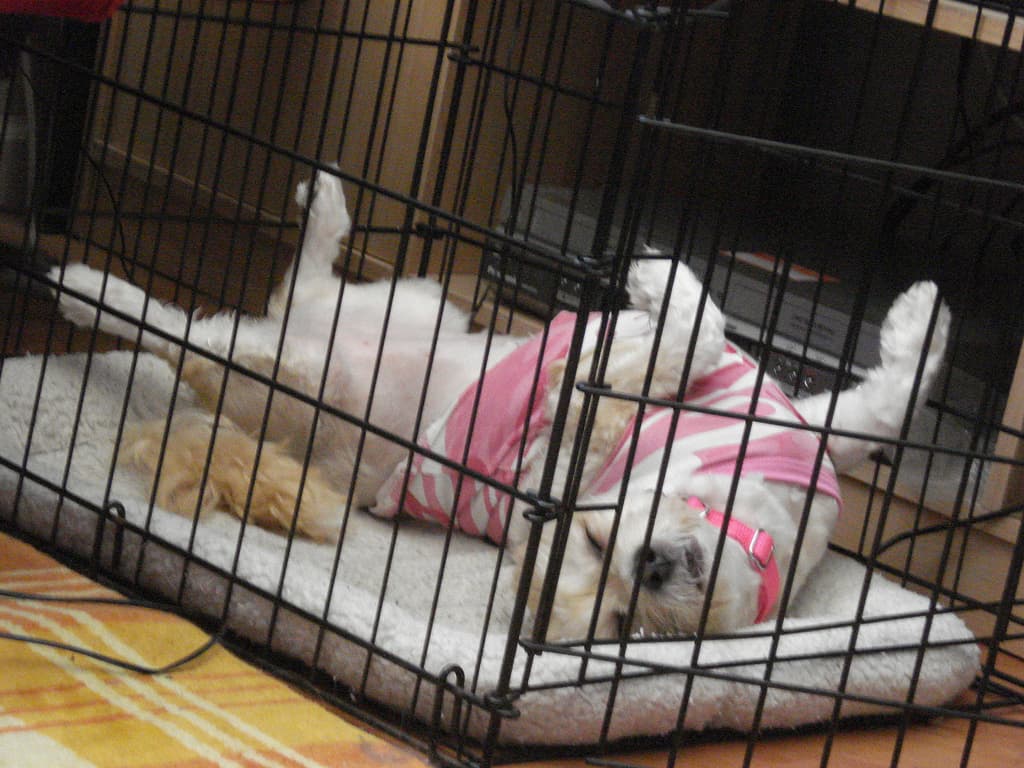
I hear many dog owners talk about how they never crate trained their pup because it made them feel bad to hear them cry.
I understand… BUT
Dog’s need rules and boundaries just as children do.
These rules and boundaries are put into place for the safety of the dog! Rules and boundaries create a safe environment for your little puppy to learn and grow in, while teaching him a healthy respect for authority. You do not want your new little pal thinking that he owns the place, and can control your every move!
Dogs need a “pack leader” to show them how to behave in their new environment. Otherwise, you will end up with a bossy and controlling dog who thinks he needs to take matters into his own hands…. This can lead to aggressive and territorial behavior in the future.
In the wild, dogs have dens, which is a small and confined area that they sleep, rest, and relax in. If introduced properly, the crate should become a den-like safety zone for your pup to retreat to when he needs a little down time. He should also happily go into it when you need him to.
It can be hard to listen to your sweet little puppy cry in his crate at first, but I promise that you will not regret the decision to stick with it. Crate training helps to create a well-balanced, level-headed dog, that knows and respects the rules and boundaries of the household.
Not to mention it helps TREMENDOUSLY with potty training, which we will touch on as well.
To read about the crates that I specifically recommend for crate training click HERE
Or here are a few quick links to some of my favs.
Crate training methods
First, Let me just throw in here that I feel it is VERY important to take off at least a week of work (if you work) to be home with a brand new puppy to help teach him the ropes, and get used to his new home and training before leaving him at all. During this time you could work on building up the amount of time you leave. Go outside for just 5 minutes first, then 15, than 30 and build up to an hour or two slowly so that he learns you will always come back. This will help prevent separation anxiety, which is very important for proper crate training. (More on this later!)
I personally have used two different methods of crate training, and for each method, I used different types of crates.
One method is based on the fact that you will be home with the puppy often, only leaving for very short periods of time. (1-2 hours at the most at first) The other method is based on if you need to leave for longer periods of time. In my opinion, a new puppy should not be left for long periods of time unless absolutely necessary, and if so, you will need to hire someone to come in at least once, and possibly two or three times, while you are gone to make sure puppy is OK, and give them some time out of their crate.
Method 1 – Traditional crate training
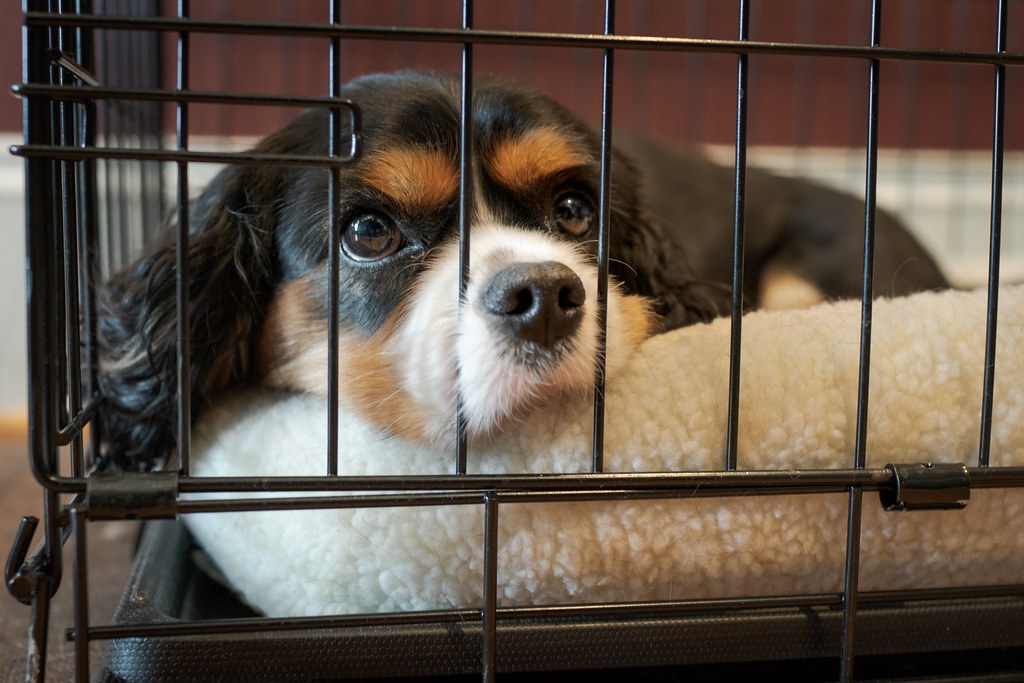
What is Traditional Crate Training?
Traditional crate training is probably the best method to use, and has been used for years upon years with success.
Let me start by saying that there is no one exact and perfect way to go about crate training. Every person and every dog is different, and you may need to modify things slightly to fit you, your dog, and your schedule. This is just my experience with crate training, and what has worked for me!
- STEP ONE – Getting your Pup used to his new “den”
Before you go putting your pup in his new crate, you need to start teaching him that the crate is a safe and happy place to be.
A simple way to do this is by letting your pup explore his new crate on his own terms, and putting fun toys and treats inside of the crate for him to check out. Every time your pup goes into his crate on his own, give him praise and a little treat.
After he has done this a few times, the next time he goes in on his own, shut the door just for a second, then open and give him a treat, and lots of praise… Use words like “good boy Fido! Good crate!” I like to use simple single words when teaching commands such as “Crate, Sit, or Down” and then, “Good Crate, Good sit, Good down.” after you have asked your pup to do something and he obeys.
Slowly start to close the door for longer periods, each time giving him a treat after you open if he was quiet and calm. Do not reward him if he is whining and crying!
This training can be done over several days to help your pup associate his crate with fun exciting toys and treats.
- STEP TWO – Using the crate. This is a long step, so bare with me…
Getting your puppy used to the crate over time is wonderful, and necessary, but you won’t be able to wait until your pup is completely fine and dandy with his crate before using it to contain him for short periods of time.
You still have a life, at least I’m pretty sure… ?… Most people cannot just train and play with their new puppy all day long without stopping to do anything else, as much as we all wish we could…
It is very important to keep your puppy in a safe place when you are unable to be with him or watch his every move. Puppies are like toddlers. They WILL get into everything. Not to mention we want this puppy house-trained as soon as possible right? Right.
So in comes the crate.
NIGHT TIME CRATE USE
I know it can be tempting to put your new cute little puppy into your bed with you at night, but if you want a crate trained dog, I would HIGHLY recommend that you have puppy sleep in his own bed at night, and you in yours.
For my yorkies, I would snuggle them in bed for maybe 5 minutes, (because I mean, you do have to get your puppy snuggles in!) and then put them in a small crate right on my nightstand or on the floor right next to my bed. If puppy started to cry I would put my fingers into the crate and let her/him lick my fingers… this has worked to calm down all of my puppies I have had except for one. For the puppy I have currently, It just made him more excited. Instead, I had to gently but firmly say, “No crying” and then ignore him until he stopped… definitely not easy, but it did work eventually… after many sleepless nights. ?
If your pup starts crying in the middle of the night (which they almost certainly will) Get up without saying a word to them, take them out for a potty break, don’t give treats if they go, just calmly say, “Good Potty” then back inside and into the crate. You want to make the nighttime potty breaks as boring as possible so that your puppy will stop waking up once he can hold his bladder. If you make the nighttime trips exciting, you can bet your bottom that they will keep begging to go out ALL NIGHT LONG.
Puppies can hold their bladder longer at night, so you only need to get up with them if they start to cry, if you are blessed with a dog that sleeps completely through on night one, then honey, ENJOY IT.
DAYTIME CRATE USE
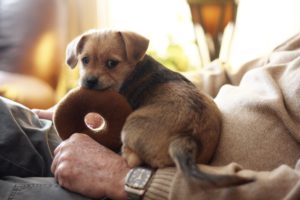
Whenever you cannot keep an eye on your new little bugger, he needs to go into his crate.This is why I recommend that you take some time off work to just be home in the first few weeks. New puppies should not have to spend more than 15-30 minutes in their crate at any one time for at least the first few days. They will need potty breaks every 30 min, they will need lots of play time and exercise, and they need nap times. (crate time)
When I am crate training with this traditional method, a typical puppy schedule day might look something like this for the first few days:
- wake up – go outside to go potty
- Playtime and training for 15-30 min (This can be done outside, or in a small space in your home, or inside a puppy playpen together)
- Go outside to go potty, maybe a little walk
- crate time for 15-30 min
AND REPEAT (of course adding their meals in there some time as well)
It is A LOT of work in the beginning doing it this way, but it is worth it, I promise you. Keeping a puppy on a predictable schedule like this is the FASTEST way to get your pup used to a crate, and going potty outside instead of inside your home.
Each day your puppy will get more and more used to his crate, especially if you keep associating it with happy things! Every time he goes in, he gets a treat, or maybe even a Kong with some peanut butter in it. Leave him with his favorite safe chew toy, and a T-shirt that smells like you for comfort.
After a few days you can up his time in his crate slowly, but you will also be upping his playtime and training time slowly as well.
SIDE NOTES ON POTTY TRAINING WITH CRATE TRAINING

Dogs naturally do not like going to the bathroom where they sleep, so you need to get an appropriate sized crate that allows your dog enough room to stand up, turn around, and lay down. No bigger, and no smaller.
A good rule of thumb for how long your puppy can hold his bladder is that they can normally wait for the number of hours equal to the number of months they are old. (give or take a bit) So if your puppy is 2 months old, he should be able to hold his bladder for roughly 2 hours. Keep in mind that smaller breeds may not be able to wait as long, and larger breeds may be able to wait a little longer.
However, just because your puppy can PHYSICALLY hold his bladder for 2 hours, it definitely does not mean that he will! Until he learns that outside is the appropriate place to go potty, he will need to go out at least every 30 min, sometimes more.
Puppies need to take a bathroom break after each of the following activities:
– After eating or taking a big drink
– After playtime
– After napping
– and whenever they are acting like they may need to go! (sniffing, circling, etc)
OK, back to the crate talk…
Spoiler alert!! – Your puppy will almost definitely cry when he goes into his crate. This is the hardest part, but it is extremely important that you ignore his crying. You can make yourself visible to him so that he knows he is safe and you are still there… (I would sometimes put puppies crate right on the kitchen counter and let him watch me do dishes or whatever I was doing!) But do not touch him, try not to even make eye contact, and certainly do not speak to him. Your pup is begging for attention and he needs to learn that crying and carrying on is not the way to get it. (just like a toddler!!)
If your puppy is being very good in his crate, and quietly watching you go about your day, you may bring him a treat and say something like “Good quiet.” Or whatever you would like, then continue going about your day… but if he starts whining and crying after that interaction remember… Ignore him.
I KNOW ITS HARD, and it feels so cruel in the moment, but OH… if you could just see into the future how well your little guy will behave in his crate, and not go potty on your floor, you will push through the tough moments.
You also need to be sure that you are not crating up your new puppy and taking off for hours at a time and leaving him alone at first. That is a very good way to create separation anxiety in your dog. He needs time to acclimate to his new home and surroundings, and he needs to learn very slowly that you will always come back for him.
Like I mentioned above, go somewhere in your home or outside for just 5 minutes first, then come back and let him see you (but do not communicate) Then leave for 10 minutes, then 15… do this over a number of days and soon your puppy will realize that sometimes you leave, but you always come back.
Eventually you will get to the point that you can leave your home for the amount of time that your dog can hold his bladder. When you leave, give him treats, and when you come back, don’t make a big deal out of it. Calmly take him out of his crate when he is calm and quiet, tell him “Good Boy” and take him outside to go potty. This will help him associate you leaving with good things, teach him to not be too over excited when you come home, and will also help encourage him to be patient for your return.
Dogs naturally feed off of our energy. If you are excited and crazy, or stressed and anxious, most likely your dog will be too. If you are calm and quiet and patient, your puppy will have an easier time learning how to be calm, quiet, and patient as well.
*NOTE – If you need to go back to work, you need to hire someone, or have a family member or friend come over and continue your puppy’s routine as many times per day that is needed. Puppy can only hold his bladder for so long.
- STEP THREE – adding a playpen to your crate setup – (optional step)

This step is optional. Some people do it right from the beginning, some people skip it entirely. What I like to do, is get my puppy used to crate training and the general idea of potty training, and once I think he is starting to get the concept, I introduce a playpen.
This is a special new privilege for your puppy and helps him to learn that he can have access to more space if he does well with his training! If you have a small room that you can block off with your dogs crate in it, you could use that in place of a playpen if desired.
Here are a couple playpen and baby gate options that I have used and like!
At this point the schedule might look something more like this:
– wake up
– go potty
– playtime/training
– quiet time in playpen (maybe chewing a bone, or a frozen Kong treat)
– possibly another potty break depending on how well your pup is doing with holding his bladder by this point.
– crate time if needed – so you can do things you need to do
– out of crate and go potty
and REPEAT.
If puppy back tracks and starts having accidents in the playpen, then just go back on your training a bit, take away the playpen privilege for a few days, buckle down and take puppy outside more for potty breaks, then try to reintroduce it again.
This is a great way to give pup a little more freedom, but still giving him appropriate boundaries as well.
NOTE – Whatever you do, do not scold, hit your pup, or rub his nose in his mess if he has an accident. Puppies will not understand that you are angry because they went inside, they will think you are just angry simply because they WENT. This may make them scared to go in front of you outside, and can also make them go inside your home in places where they don’t think you will see them.
Disciplinging a dog in this way will only create set backs, and will hinder their trust in you and relationship with you as well.
Instead, just calmly say “No” and take your puppy to his correct potty spot. If you did not see your puppy make the mess, just clean it up, and move on. It is no use telling him no and bringing him outside if you did not catch him in the act.
- STEP FOUR – House freedom paired with crate training.
Once you get to this step, your dog should be very used to his crate, and behave and hang out quietly while he is in it. He should also be fully potty trained, and trust worthy in a play pen or other small area of your home.
When he has gotten to this point, he is ready to start having more freedom in your home.
This can look however you want it to look.
If freedom in your home means he has complete access to every part of you house, then start working with him on that… same rules apply here as above. If he starts having accidents or chews up momma’s slipper, go back to the play pen or small room for a few days, and try again later.
Freedom in your house may mean to you that he has access to everywhere except bedrooms, or except the basement. It could mean he can be out and about when you are home and crated when you leave, or it could mean he can have freedom even when you leave as well! (You will have to very slowly work up to this, and I’d recommend using the playpen and/or small room when you leave for a while first)
Every dog is different. Some dogs can be trusted with more freedom sooner, and some dogs may take two years before they can have complete free-range of your home. My pup Oakley is almost a year old and is still only allowed free roam when I am around to keep a close eye on him. He’s very mischievous… ? My pup I had before him was able to have free roam by a year and a half old.
The important part is to be patient, and work with your dog and his personal needs!
That’s about it for Crate Training Method 1, now lets talk about the 2nd Method I have used in the past.
Method 2 – Crate Training with a Playpen and potty pads.

Method 2 is sort of two methods in one. Both of the ones I will talk about uses a crate and potty pads, but one is where you do a complete indoor potty training at first, and the other is outdoor potty training with potty pads only when you cannot be home.
Keep in mind that this method is something I would only recommend if you absolutely cannot do method 1 for one reason or another.
This is the method I used for my last Yorkie when I could only take 4 days off work to be with her, and had to go back to work after that. It is not impossible to get a puppy and still work a normal job, but it is a lot harder, and usually more expensive because you will probably need to hire a dog sitter to stop by once or twice a day.
(I also only worked part-time, so it wasn’t as bad finding a pet sitter for only 3 days per week)
When I did this method, I used the Potty Training Puppy Apartment (PTPA). You can read all about the PTPA and the full review of my experience with it HERE. If you decide you would like to try this crate, you can purchase it HERE, and be sure to use this code at check out to get you a 5% discount! 🙂 – ATY27604
Below is a quick video about how it works…
The PTPA is essentially a dog crate that has two separate sections. One is a small section for sleeping, and the other is a potty area where you place a potty pad down. This method teaches your dog to first use an indoor bathroom. When the pup is older and can hold his bladder longer then you can start training him to go outside instead, OR you can keep him using an indoor potty permanently if you prefer!
The idea is that your puppy will only use the potty side of the crate for his business and will naturally keep the bed area clean. Which in my experience, does work very well!
You could also just use a regular crate and a playpen with potty pads in one area of the play pen. In this case I would continue to try to get your pup to use the potty outside when you are home, and only use potty pads when you leave. If you go with this route, then the potty pad is mostly used just in case of an accident, not to train him to use an indoor potty altogether.
How to get set up for this method.
My set up consisted of the PTPA crate itself and a playpen attached to it. For the first few days that I was home with my new puppy, I got her used to the crate as best as I could, and praised her like crazy whenever she used the potty area.
If not using the PTPA, you will just need a regular crate, with a playpen attached to it.
I will keep the steps about this method a bit shorter, because they are very similar as the steps above with just a few differences. I will tell you just the differences, so please read steps above as well to get all the info you need for general crate training!
STEP ONE – Getting used to the PTPA or regular crate.
This step is the same as the first step above. See Step One above for details!
STEP TWO – Using the PTPA (or crate with puppy pads in play pen)
NIGHT TIME CRATE USE
If using the PTPA – Have your puppy sleep in this crate at night so that they can let themselves to the bathroom when needed. They should naturally use the side with the puppy pad in order to avoid soiling their bed. One upside to using the PTPA is that you do not have to get up with puppy in the middle of the night! 😉
If using a regular crate and playpen with potty pads. – Same rules apply as method one for nighttime crate use. See above.
DAYTIME CRATE USE
PTPA – Your schedule will look something like this:
- Wake up – do not let puppy into playpen until they have used their potty section. When they use their potty, praise them and give them a treat while saying “Good Potty!!” Just like you would if they were going outside.
- Playtime/Training
- Potty time – Place them back into their crate and encourage them to go potty. When they go, more praise and treats!
- Nap time – Have them stay in their crate for nap time
- Potty time – They will wake up and go potty when they need to.
REPEAT
Puppies tend to get used to using the PTPA potty very quickly. It is certainly an easy method for potty training if you wish to teach them to use an indoor potty, or if you need to be at work.
After a few days of them getting used to their new crate and potty system, you can start allowing them to have access to the play pen as well. They should be starting to get the hang of their potty and will go into the crate when they need to use it. If they have an accident, tell them a firm “no” and put them into their potty area instead.
This is the set up you will leave them in when you need to go to work. That way, the have access to a bed, a potty, and a little free space to roam and play.
However, I would still highly recommend following the advice above from the first method, and getting them used to you leaving slowly to not create separation anxiety. This is why it is SO important to take at least 3-4 days off work, and hopefully a week or two if possible when you first bring your puppy home.
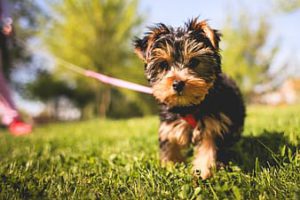
I also recommend hiring someone, or finding a friend or family member when you do go back to work, to come check on your puppy, and give them a snack, fresh water, (in case they are out) and a playtime/romp around at least once and possibly twice while you are gone. Puppies are just not meant to be alone for more than a few hours at a time. They need a lot of interaction, training, and playtime to burn off energy so they are well-behaved.
*NOTE – because this is primarily a Yorkie and small dog website, I feel the need to insert a little note about hypoglycemia in small dogs. Smaller dogs need to eat more often so that they do not become hypoglycemic. You can read more about this sad condition HERE. Hypoglycemia can kill a small puppy very quickly if it goes unnoticed. This is just another very important reason to have someone come check on your puppy often if you cannot be home. Your pup should get some kind of snack each time someone visits them to keep their blood sugar levels stable. It would not be a bad idea to put just a pea size drop of Karo syrup into their water as well when you need to leave.
Regular Crate with Play pen and potty pads
With this method your schedule will look similar to the PTPA schedule, but potty time will be outside when you are home (if your goal is to have them use outside for a potty in the long run) and when you are not home they can use the potty pads inside the playpen.
Again, someone should be stopping by once or twice to clean up any messes, take them out to try and go potty outside, feed, and play with your puppy.
STEP 3 – using a playpen with your crate
Step 3 does not apply to this method, given that you start out right away with a play pen, seems you will be gone for longer periods of time.
STEP 4 – House freedom paired with crate training.
This step is very much like step 4 with traditional crate training.
With the PTPA, your puppy should be reliably using his indoor potty almost all the time with little to no accidents. He should also be trustworthy and not chewing on your belongings or getting into other mischief.
Once he is to this point, you may choose to leave him in a specific area of your home, or let him have free-range of the home while you are gone, and leave his door open to his crate so he can go in to use his potty, or take a nap.
With a regular crate, step 4 is the same as above. Your pup can be crated when you leave if you so choose, or if he is trustworthy enough, you can start leaving him out. Just be sure not to leave him for longer than he can hold his bladder!
Just like with traditional crate training, this step will look different for every dog, and will take different amounts of time to reach this step with each dog. Be patient and enjoy the process! 🙂
Crate Training Success!
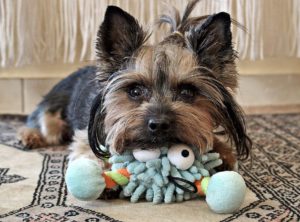
With any kind of dog training, the key to success is CONSISTENCY. Find a schedule, and method that works for you and your pup, and stick to it. If you need to bring in a dog sitter, be strict about them sticking to your schedule and training as well.
It is a lot of work in the beginning, but the results of a dog that can quietly be in his crate, and doesn’t pee on your carpet, is well worth the time put in.
If you do not have the time or resources for any of this training, please wait to get a puppy until you do! It is no fun for either of you if you do not have the time or ability to invest into a well-behaved canine member of your family. ?
There is A LOT that goes into crate training guys, hence this long post. So if I forgot anything, or if you’re running into problems while crate training your new puppy, please do not hesitate to reach out to me!
I will do my best to answer any questions you may have. 🙂
P.S. Don’t forget to use this code at checkout – ATY27604 – if you decide to purchase a Potty Training Puppy Apartment! 5% discount woohoo!!
 – Save this information for later, and help us spread the word by pinning this post to Pinterest!
– Save this information for later, and help us spread the word by pinning this post to Pinterest!
Hover over or tap the photo to see the SAVE option.
Related Posts:
- My absolute favorite dog crates to use for Crate training and potty training!
- My complete review on the Potty Training Puppy Apartment!
- Yorkie Puppy Care – Your complete guide for life with your new Yorkie, Yorkie mix, or other small dog!
Popular Posts:
- How to groom your Yorkie, Yorkie mix, or other small dog, right from your home. – with video tutorial!
- How to bathe your small dog at home to ensure they’re squeaky clean and feeling great! – With video tutorial.
- The five BEST dog clippers for grooming your pup at home.


Hello Sarae,
This is an excellent post on crate training a puppy.
We adopted a Labrador and he’s already 7 years old. He’s a big baby and has a separation anxiety disorder. Apparently, his previous owner left him alone in the house for 8 hours or more a day and so he destroyed stuff in the house. So, they moved him to the yard and put him in the leash and again left him with food and water alone all day for work. So, when he’s with us, every time we leave the house just to run errands, it takes a lot of time and energy to keep him calm and let us go. When we come back, there’s always something he’ll chew on (shoes even windows). I wish we could train him to stay in a big kennel, but he didn’t even want to go in, no matter how big the kennel is. We even made him playpen but he’s such a jumper. It didn’t work too.
Do you have any ideas what we could do for him?
wow that is tough.. Separation anxiety is definitely difficult to reverse once it is deeply set in. Honestly, I know this isn’t super helpful, but my best advice would be to bring in a trainer to help him overcome, or look into a doggy daycare he can go to here and there so that he doesn’t have to be alone as much.
Thank you for this informational post. I think this is a post that every single person who has a dog or is just interested in dog training should read. Personally I don’t have a dog but I have always been interested in what methods people use to train their dogs. I am amazed by how intelligent those animals are. Do you think that the environment the dog lives in plays a role in its training? What I mean is do you think that a dog that lives in an apartment should be trained differently than a dog that lives in the house?
I do think it would be simpler to train an apartment dog with the potty training puppy apartment, as you would not necessarily need to take the dog out to use the bathroom, and you may have to be home a bit more in an apartment to ensure your pup isn’t barking and carrying on while you are gone and possibly disturbing neighbors!